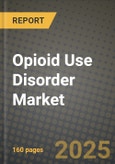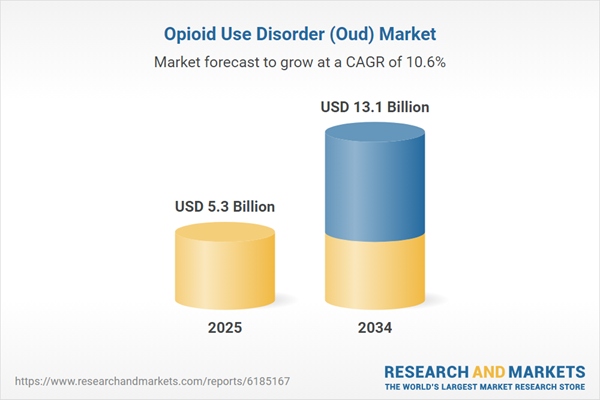The opioid use disorder (OUD) market is witnessing substantial growth due to the rising prevalence of opioid addiction, increased awareness of treatment options, and expanding government initiatives to combat the opioid crisis. OUD is a chronic medical condition characterized by compulsive opioid use despite harmful consequences, leading to severe health and social issues. The market comprises medication-assisted treatments (MAT) such as buprenorphine, methadone, and naltrexone, as well as behavioral therapies and digital therapeutics. The introduction of long-acting formulations, implantable devices, and innovative non-opioid therapies is transforming the treatment landscape. Governments and healthcare agencies are strengthening policies to expand treatment accessibility, integrate harm reduction strategies, and reduce opioid-related overdoses. The shift toward personalized medicine and AI-driven digital interventions is also improving patient adherence and long-term recovery outcomes. With an increasing focus on reducing stigma and enhancing opioid addiction treatment services, the OUD market is expected to grow further, providing better healthcare solutions for affected individuals.
The OUD market experienced significant advancements in long-acting medication therapies, telemedicine-based treatment programs, and digital addiction management solutions. The approval and widespread adoption of extended-release buprenorphine injections and subdermal implants improved patient adherence and reduced the need for frequent clinic visits. Telehealth services played a pivotal role in expanding access to MAT, particularly in underserved regions, allowing remote prescribing and virtual counseling. The integration of AI-powered digital therapeutics gained momentum, offering real-time patient monitoring, relapse prevention strategies, and personalized recovery plans. Additionally, government funding and policy reforms facilitated the expansion of harm reduction programs, including increased distribution of naloxone kits to prevent opioid overdose deaths. The pharmaceutical industry also saw a surge in non-opioid-based treatment research, with novel drug candidates targeting opioid cravings and withdrawal symptoms without the risk of dependency. The growing collaboration between public health agencies, rehab centers, and pharmaceutical companies further strengthened the OUD treatment ecosystem, making therapies more accessible and effective.
The opioid use disorder market is expected to witness transformative developments driven by precision medicine, AI-driven behavioral health interventions, and advancements in non-opioid pharmacotherapies. Personalized treatment plans based on genetic and biomarker profiling will enable more targeted medication approaches, optimizing effectiveness and minimizing side effects. AI-driven digital platforms will continue to enhance recovery support, integrating predictive analytics to identify relapse risks and offer timely interventions. The emergence of novel non-opioid medications, including NMDA receptor antagonists and cannabinoid-based therapies, will provide alternative treatment options for opioid dependence. Policymakers are expected to enforce more regulations supporting harm reduction initiatives, including supervised consumption sites and medication distribution expansion. Additionally, insurance coverage for MAT and behavioral therapies is likely to improve, reducing financial barriers to treatment. As the stigma surrounding addiction treatment diminishes and innovative therapies gain traction, the OUD market is poised for significant growth, offering more comprehensive and personalized solutions for long-term recovery.
Key Insights: Opioid Use Disorder (Oud) Market
Expansion of Digital Therapeutics for OUD Treatment: Digital therapeutics are revolutionizing opioid addiction treatment by providing AI-powered mobile apps, wearable monitoring devices, and virtual cognitive behavioral therapy (CBT) programs. These platforms use real-time patient data to track adherence, predict relapse risks, and offer automated interventions. AI-driven chatbots and virtual coaching services enhance patient engagement, improving long-term recovery success rates. With the increasing adoption of digital health solutions, digital therapeutics are becoming a critical component of integrated OUD treatment strategies, complementing medication-assisted therapies and behavioral interventions.Rise in Non-Opioid Pharmacotherapies: The development of non-opioid treatment alternatives is gaining momentum as researchers explore novel mechanisms for managing opioid cravings and withdrawal symptoms. NMDA receptor modulators, cannabinoid-based therapies, and kappa-opioid receptor antagonists are emerging as promising candidates for OUD treatment. These therapies aim to reduce dependency risks while offering effective symptom relief. As concerns over the long-term use of opioid replacement therapies persist, non-opioid pharmacotherapies are expected to reshape the treatment landscape, providing safer and more sustainable options for managing opioid addiction.
Government Initiatives and Funding for OUD Treatment: Governments worldwide are implementing aggressive strategies to combat the opioid crisis, including increased funding for MAT programs, harm reduction initiatives, and public awareness campaigns. Regulatory bodies are expanding access to naloxone, supporting the establishment of supervised consumption sites, and incentivizing the development of innovative treatment solutions. Policies promoting insurance coverage for OUD therapies are also improving affordability, ensuring that more patients receive timely and effective treatment. These efforts are significantly driving market growth, making opioid addiction care more accessible.
Growing Adoption of Telemedicine and Remote OUD Treatment: The expansion of telemedicine is revolutionizing OUD treatment by providing remote access to healthcare providers, medication-assisted therapies, and counseling services. Virtual consultations eliminate geographic barriers, particularly benefiting patients in rural and underserved areas. Online prescribing platforms and digital counseling programs enhance patient engagement and treatment adherence. As telehealth regulations evolve to support long-term addiction management, the widespread adoption of virtual healthcare solutions is expected to further drive the accessibility and effectiveness of OUD treatment programs.
Stigma and Limited Awareness of OUD Treatment Options: Despite advancements in OUD therapies, stigma remains a significant barrier to treatment, preventing many individuals from seeking help. Social and cultural biases against medication-assisted treatment contribute to underutilization, while misinformation about addiction recovery options limits awareness. Addressing this challenge requires continuous public education, destigmatization campaigns, and healthcare provider training to promote evidence-based treatment approaches and encourage more individuals to access life-saving OUD interventions.
Opioid Use Disorder (Oud) Market Segmentation
By Drug Type
- Buprenorphine
- Naltrexone
- Methadone
By Route of Administration
- Oral
- Parenteral
By Age Group
- 19 To 40
- 41 To 60
- 61 and Over
By Distribution Channel
- Hospital Pharmacies
- Retail Pharmacies and Stores
- Online Pharmacies
Key Companies Analysed
- Pfizer Inc.
- Novartis AG
- AstraZeneca plc.
- Viatris Inc.
- Teva Pharmaceutical Industries Ltd.
- Chiesi Pharmaceuticals S.p.A.
- Hikma Pharmaceuticals Plc.
- Mallinckrodt Pharmaceuticals
- Indivior Plc.
- Knight Therapeutics Inc.
- Purdue Pharma L.P
- Alkermes Inc.
- Collegium Pharmaceutical Inc.
- Vanda Pharmaceuticals Inc.
- Camurus AB
- Tris Pharma Inc.
- Mylan NV.
- Orexo US Inc.
- Zogenix Inc.
- Rhodes Pharmaceuticals L.P.
- Omeros Corporation
- Braeburn Pharmaceuticals Inc.
- Adapt Pharma Inc.
- Titan Pharmaceuticals Inc.
- BioDelivery Sciences International Inc.
- Insys Therapeutics Inc.
- MediciNova Inc.
- Cara Therapeutics Inc.
- AcelRx Pharmaceuticals Inc.
- KemPharm Inc.
Opioid Use Disorder (Oud) Market Analytics
The report employs rigorous tools, including Porter’s Five Forces, value chain mapping, and scenario-based modeling, to assess supply-demand dynamics. Cross-sector influences from parent, derived, and substitute markets are evaluated to identify risks and opportunities. Trade and pricing analytics provide an up-to-date view of international flows, including leading exporters, importers, and regional price trends.Macroeconomic indicators, policy frameworks such as carbon pricing and energy security strategies, and evolving consumer behavior are considered in forecasting scenarios. Recent deal flows, partnerships, and technology innovations are incorporated to assess their impact on future market performance.
Opioid Use Disorder (Oud) Market Competitive Intelligence
The competitive landscape is mapped through proprietary frameworks, profiling leading companies with details on business models, product portfolios, financial performance, and strategic initiatives. Key developments such as mergers & acquisitions, technology collaborations, investment inflows, and regional expansions are analyzed for their competitive impact. The report also identifies emerging players and innovative startups contributing to market disruption.Regional insights highlight the most promising investment destinations, regulatory landscapes, and evolving partnerships across energy and industrial corridors.
Countries Covered
- North America - Opioid Use Disorder (Oud) market data and outlook to 2034
- United States
- Canada
- Mexico
- Europe - Opioid Use Disorder (Oud) market data and outlook to 2034
- Germany
- United Kingdom
- France
- Italy
- Spain
- BeNeLux
- Russia
- Sweden
- Asia-Pacific - Opioid Use Disorder (Oud) market data and outlook to 2034
- China
- Japan
- India
- South Korea
- Australia
- Indonesia
- Malaysia
- Vietnam
- Middle East and Africa - Opioid Use Disorder (Oud) market data and outlook to 2034
- Saudi Arabia
- South Africa
- Iran
- UAE
- Egypt
- South and Central America - Opioid Use Disorder (Oud) market data and outlook to 2034
- Brazil
- Argentina
- Chile
- Peru
Research Methodology
This study combines primary inputs from industry experts across the Opioid Use Disorder (Oud) value chain with secondary data from associations, government publications, trade databases, and company disclosures. Proprietary modeling techniques, including data triangulation, statistical correlation, and scenario planning, are applied to deliver reliable market sizing and forecasting.Key Questions Addressed
- What is the current and forecast market size of the Opioid Use Disorder (Oud) industry at global, regional, and country levels?
- Which types, applications, and technologies present the highest growth potential?
- How are supply chains adapting to geopolitical and economic shocks?
- What role do policy frameworks, trade flows, and sustainability targets play in shaping demand?
- Who are the leading players, and how are their strategies evolving in the face of global uncertainty?
- Which regional “hotspots” and customer segments will outpace the market, and what go-to-market and partnership models best support entry and expansion?
- Where are the most investable opportunities - across technology roadmaps, sustainability-linked innovation, and M&A - and what is the best segment to invest over the next 3-5 years?
Your Key Takeaways from the Opioid Use Disorder (Oud) Market Report
- Global Opioid Use Disorder (Oud) market size and growth projections (CAGR), 2024-2034
- Impact of Russia-Ukraine, Israel-Palestine, and Hamas conflicts on Opioid Use Disorder (Oud) trade, costs, and supply chains
- Opioid Use Disorder (Oud) market size, share, and outlook across 5 regions and 27 countries, 2023-2034
- Opioid Use Disorder (Oud) market size, CAGR, and market share of key products, applications, and end-user verticals, 2023-2034
- Short- and long-term Opioid Use Disorder (Oud) market trends, drivers, restraints, and opportunities
- Porter’s Five Forces analysis, technological developments, and Opioid Use Disorder (Oud) supply chain analysis
- Opioid Use Disorder (Oud) trade analysis, Opioid Use Disorder (Oud) market price analysis, and Opioid Use Disorder (Oud) supply/demand dynamics
- Profiles of 5 leading companies - overview, key strategies, financials, and products
- Latest Opioid Use Disorder (Oud) market news and developments
Additional Support
With the purchase of this report, you will receive:- An updated PDF report and an MS Excel data workbook containing all market tables and figures for easy analysis.
- 7-day post-sale analyst support for clarifications and in-scope supplementary data, ensuring the deliverable aligns precisely with your requirements.
- Complimentary report update to incorporate the latest available data and the impact of recent market developments.
This product will be delivered within 1-3 business days.
Table of Contents
Companies Mentioned
- Pfizer Inc.
- Novartis AG
- AstraZeneca PLC
- Viatris Inc.
- Teva Pharmaceutical Industries Ltd.
- Chiesi Pharmaceuticals S.p.A.
- Hikma Pharmaceuticals PLC
- Mallinckrodt Pharmaceuticals
- Indivior PLC
- Knight Therapeutics Inc.
- Purdue Pharma L.P
- Alkermes Inc.
- Collegium Pharmaceutical Inc.
- Vanda Pharmaceuticals Inc.
- Camurus AB
- Tris Pharma Inc.
- Mylan NV.
- Orexo US Inc.
- Zogenix Inc.
- Rhodes Pharmaceuticals L.P.
- Omeros Corporation
- Braeburn Pharmaceuticals Inc.
- Adapt Pharma Inc.
- Titan Pharmaceuticals Inc.
- BioDelivery Sciences International Inc.
- Insys Therapeutics Inc.
- MediciNova Inc.
- Cara Therapeutics Inc.
- AcelRx Pharmaceuticals Inc.
- KemPharm Inc.
Table Information
| Report Attribute | Details |
|---|---|
| No. of Pages | 160 |
| Published | October 2025 |
| Forecast Period | 2025 - 2034 |
| Estimated Market Value ( USD | $ 5.3 Billion |
| Forecasted Market Value ( USD | $ 13.1 Billion |
| Compound Annual Growth Rate | 10.6% |
| Regions Covered | Global |
| No. of Companies Mentioned | 30 |









